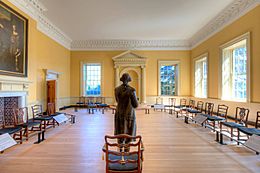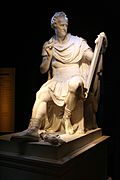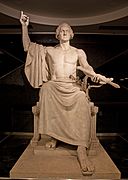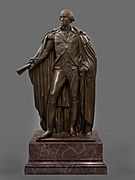George Washington's resignation as commander-in-chief facts for kids
Quick facts for kids 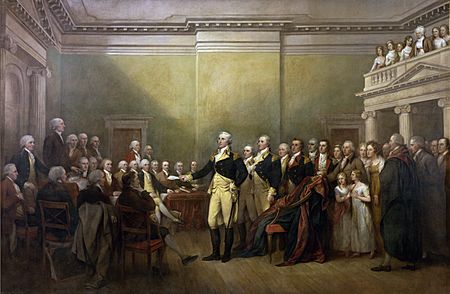
General George Washington Resigning His Commission
by John Trumbull |
|
| Date | December 23, 1783 |
|---|---|
| Venue | Maryland State House |
| Location | Annapolis, Maryland |
George Washington's resignation as commander-in-chief was a very important moment in American history. It marked the end of Washington's time leading the army in the American Revolutionary War. After the war, he chose to return to his home at Mount Vernon as a regular citizen.
This act of giving up power was seen as a great example of leadership. It helped create the idea that in America, the military is always controlled by civilian leaders, not by generals. After the Treaty of Paris officially ended the war on September 3, 1783, and the last British soldiers left New York City on November 25, Washington resigned. He gave up his role as the main leader of the Continental Army to the Congress of the Confederation. This government group was meeting in the Maryland State House in Annapolis, Maryland, on December 23, 1783.
Before this, Washington had said goodbye to his army on November 2 near Princeton, New Jersey. He also said goodbye to his officers on December 4 in New York City. Washington's resignation was later painted by John Trumbull in 1824. This famous painting, General George Washington Resigning His Commission, can be seen today in the United States Capitol rotunda.
Contents
The Historic Day: Washington Gives Up Power
Washington arrived in Annapolis on December 19, 1783. He was welcomed by other generals. The next day, he asked the Congress how he should resign. The leader of the Congress, Thomas Mifflin, set up a small group to plan the details.
A Hero's Welcome in Annapolis
On December 22, Congress honored Washington with a big dinner. Between 200 and 300 people attended. Later that night, the Governor of Maryland, William Paca, held a public ball for him at the State House. Nearly 600 guests were there! Historian Willard Sterne Randall wrote that Washington, who was known as a good dancer, "astonished French officers with his skill and grace."
Washington's Farewell Speech
At noon on December 23, Charles Thomson, the secretary of the Continental Congress, led Washington into the Senate Chamber of the Maryland State House. Washington was joined by two of his helpers, Col. David Humphreys and Col. Benjamin Walker. Even though some paintings show her there, Washington's wife, Martha Washington, was not actually present.
Washington then gave a speech to the people gathered. He said:
Happy that our Independence is confirmed, and pleased that the United States can become a respected Nation, I gladly give up the job I wasn't sure about taking.
…
I must end this last important act of my public life by asking God to protect our dear Country. I also ask Him to guide those who are in charge of it.
Now that I have finished the work given to me, I am leaving public life. I say a warm goodbye to this important group, whose orders I have followed for so long. I now offer my Commission, and leave all public jobs.—George Washington
As his final act, Washington handed his official papers and his speech to President Mifflin. The very next day, December 24, Washington left Annapolis to go back to his home, Mount Vernon.
Why Washington's Resignation Was So Important
Historians agree that Washington's decision to give up his power was incredibly significant. It set a strong example for future leaders in America and around the world.
A Modern-Day Cincinnatus
Historian Gordon S. Wood compared Washington to Lucius Quinctius Cincinnatus. Cincinnatus was an ancient Roman hero who, after winning wars, famously returned to his farm. Wood wrote that Washington was "the perfect Cincinnatus." He believed that Washington's resignation was "the greatest act of his life."
A King's Admiration
Even King George III, the British king Washington fought against, admired his action. In 1797, the king told American painter Benjamin West that Washington's resignation made him "the most distinguished of any man living." He thought Washington was "the greatest character of the age." This shows how impressive Washington's choice was, even to his former enemy.
An Example for the World
John Trumbull, the artist who painted Washington's resignation, was amazed by it. He wrote that it "excites the astonishment and admiration of this part of the world." He felt it was "a Conduct so novel, so inconceivable to People, who, far from giving up powers they possess, are willing to convulse the Empire to acquire more." Trumbull later called Washington's resignation "one of the highest moral lessons ever given to the world."
Historian Thomas Fleming also stressed the importance of the event. He said it was "the most important moment in American history." Washington could have kept his power and become a ruler, but he chose to become a private citizen. This showed that he believed in the new American system of government, where power belonged to the people.
Artistic Views of the Resignation
Washington's resignation has been shown in many artworks, including paintings and sculptures. These artworks help us remember this important moment in history.
- In 1821, Raimondo Trentanove carved a bas-relief (a type of sculpture that sticks out from a flat surface) of this scene. It was part of the base for Antonio Canova's statue of George Washington.
- John Trumbull's famous 1824 painting, General George Washington Resigning His Commission, is a life-size artwork. You can see it in the United States Capitol rotunda.
- In 1829, sculptor Enrico Causici created a statue of Washington resigning. This statue sits on top of the Washington Monument in Baltimore.
- Horatio Greenough finished his sculpture of George Washington in 1840. It shows Washington giving power back to the people. This sculpture is now at the National Museum of American History.
- Around 1841, Ferdinand Pettrich made a painted plaster sculpture called Washington Resigning His Commission. It is now at the Smithsonian American Art Museum.
- In 1858, Edwin White painted Washington Resigning His Commission. This painting was ordered by the Maryland Legislature and is on display in the Maryland State House.
- In 1903, Edwin Blashfield created a large wall painting (mural) called Washington Surrendering His Commission. It shows Washington placing his commission at the feet of a figure representing America. This mural is in the Clarence Mitchell Courthouse in Baltimore.
Images for kids
-
George Washington
by Antonio Canova, plaster replica -
George Washington resigning his commission atop the Washington Monument in Baltimore
by Enrico Causici, 1829 -
George Washington
by Horatio Greenough, 1840


